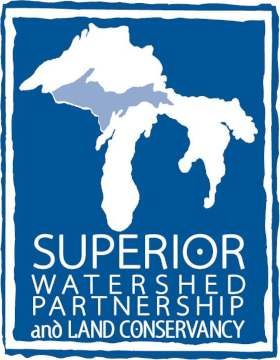SWP Helps Protect Severely Declining Monarch Butterfly!
Marquette, MI – The Superior Watershed Partnership (SWP) is wrapping up a summer long season of monarch butterfly habitat restoration on the Stonington Peninsula. In partnership with the U.S. Forest Service’s Hiawatha National Forest (HNF) and with funding from the National Forest Foundation (NFF), the SWP will plant the final native pollinator plants for the season in the coming weeks. The SWP and project partners have been restoring important pollinator habitat for nearly 5 years.
Monarch butterflies travel thousands of miles from Canada and the United States to winter in the mountain forests of central Mexico. And countless numbers of these butterflies funnel right through the Stonington Peninsula in the south central Upper Peninsula. This rural peninsula juts out into Lake Michigan between the Big and Little Bay de Nocs. There are only two roads on this 2 mile long spit of land, both leading to the tiny fishing hamlet of Stonington where a small dock sits next to a NOAA weather station. From there, a short dirt road leads to the Peninsula Point Lighthouse. The peninsula is well known for bird and butterfly migration stopover habitat, but less known is the peninsula’s dire importance for monarchs, specifically, as they make their long journey to the south. The Stonington is primarily owned by the HNF, and thanks to financial assistance from the NFF,is the site of a long history of monarch butterfly habitat restoration by the SWP and HNF.
Research suggests the population of monarch butterflies in the eastern U.S. has declined by 90% — a figure so staggering that one researcher commented: “in human terms it would be like losing every living person in the U.S. except those in Florida and Ohio.” The decrease, many scientists believe, is due to threats experienced on the butterflies’ migration. When they start their journey each year, monarchs rely on specific plants for food and reproduction – common milkweed (Asclepias syriaca) being the primary species. Milkweed is a native plant that provides plenty of value to butterflies, wasps, and bees, but is of little use to farmers, who use herbicides to keep it in check. While en route to their wintering grounds, scientists also believe monarchs are facing more extreme weather conditions including higher-than-normal temperatures and storms. The current global collapse in monarch populations has reinforced the meaning and importance of efforts like the SWP/HNF collaborative monarch restoration project.
What does the project entail? For the last several years thousands of pollinator plants are raised from seed at the HNF Greenhouse in Marquette. It takes hundreds of volunteer hours to keep these plants growing – from watering to separating overly crowded seedlings. Species important to monarchs are raised but others important for the survival of bees, bats, and other pollinator insects are also cultivated – such species as black-eyed Susan (Rudbeckia serotina), bee balm (Monarda fistulosa), a variety of asters (Aster spp.), and coneflower (Rudbeckia spp.) in addition to common milkweed. Prior to any planting on the Stonington Peninsula, the SWP and HNF send field crews to pull invasive species. Plants such as houndstongue (Cynoglossum offiinale), spotted knapweed (Centaurea stoebe), and marsh thistle (Cirsium palustre) are among the many invasive species removed at the monarch openings.
Once the native plants reach the appropriate height and age, HNF and SWP staff and volunteers plant the seedlings at targeted monarch habitat openings on the Stonington Peninsula.
Hundreds of volunteers have helped in the some stage of the process, including students from North Star Academy and Northern Michigan University, MSU Extension’s Life of Lake Superior, Central Upper Peninsula Cooperative Weed Management Area, and others from the Hiawatha Interpretive Association. Since 2011, the SWP, HNF and project partners have planted over 150,000 native plants to establish and restore pollinator habitat in the Central UP, with almost a quarter of those being on the Stonington Peninsula.
